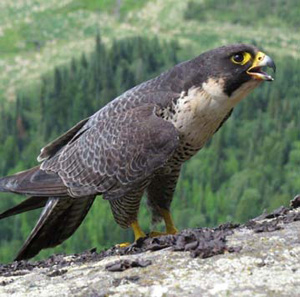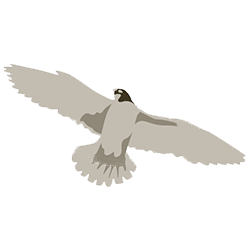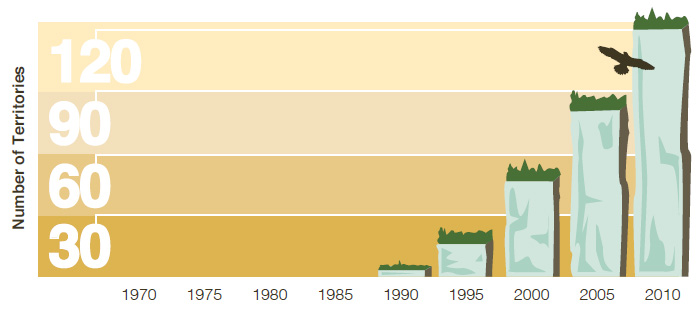Peregrine Falcon

Species description
The Peregrine Falcon (Falco peregrinus) is a crow-sized bird with a bluish-grey back and a cream-coloured chest with blackish markings. A dark colouration on their heads gives a hooded or “helmeted” appearance and adults have a prominent black “moustache”. Peregrine Falcons also have bright yellow feet and legs and long, pointed wings. Females are 15 to 20 percent larger than males.
The majority of Peregrine Falcon nests occur within the Lake Superior basin in northwestern Ontario, although they also nest in urbanized areas in southern Ontario. Peregrine Falcons often nest in one of two types of habitat: steep cliff faces close to water and forests or on ledges in urban areas, including on tall buildings or bridges. They can also nest in quarries and open-pit mines. The species demonstrates strong fidelity to nest sites and typically returns to the habitat types in which they were raised. A map of the provincial distribution of the Peregrine Falcon is available on the Government of Ontario’s species at risk website.
The Peregrine Falcon faces several threats to its survival and recovery. One of their largest threats is environmental contamination. Peregrine Falcons are predators at the top of the food chain and contaminants can accumulate in the species as a result of consuming contaminated prey. The use of dichlorodiphenyltrichloroethane (DDT), which was widely used in the 1950s and 1960s on agricultural crops to kill insects, caused the eggshells of Peregrine Falcons to be abnormally thin and resulted in reduced breeding success. DDT was banned from use in Canada in the 1970s; however, Peregrine Falcons continue to be exposed to DDT in some of their migratory and overwintering grounds. New and emerging chemicals such as polybrominated diphenyl ethers (PBDEs), which are a class of additive flame retardants, are also a concern for this species. Additional threats to the species include disturbance (human disturbances in or around nest sites), collisions with inanimate objects (such as buildings or automobiles), and habitat loss or change.
The Peregrine Falcon is listed as special concern at both the provincial (Species at Risk in Ontario List) and federal (Schedule 1 under the Species at Risk Act) levels. Globally, it is considered to be apparently secure.
Provincial status
In 1973, the Ministry of Natural Resources and Forestry (“the Ministry” or MNRF) recommended that the Peregrine Falcon be designated as endangered and regulated under Ontario’s previous Endangered Species Act. The Committee on the Status of Species at Risk in Ontario (COSSARO) reassessed the species as threatened and it was downlisted on the Species at Risk in Ontario List in 2006. The Peregrine Falcon was reassessed by COSSARO as special concern and the Species at Risk in Ontario List was amended to reflect the change from threatened to special concern on January 24, 2013. In future assessments, COSSARO may consider information regarding the species’ threats and trends in population and distribution gained through protection and recovery actions.
Species and habitat protection
The Peregrine Falcon and its habitat were protected under the previous Endangered Species Act from 1973-2006.
As a threatened species, the Peregrine Falcon received protection from being killed, harmed, harassed, captured or taken when the ESA came into force in 2008.
In addition, the habitat of Peregrine Falcon was protected from being damaged or destroyed in 2010, when the Ministry developed a habitat regulation for the species.
A government-led action identified in the government response statement is to protect the Peregrine Falcon and enforce the regulation protecting the specific habitat of the species. Peregrine Falcon and its habitat were protected under the previous Endangered Species Act from 1973 until 2006 when the species’ status was changed to threatened and the species was removed from Ontario Regulation 328 under the previous Endangered Species Act. As a threatened species, the Peregrine Falcon received protection from being killed, harmed, harassed, captured or taken when the Endangered Species Act, 2007 (ESA or “the Act”) came into force in 2008. In addition, the habitat of Peregrine Falcon was protected from being damaged or destroyed in 2010, when the Ministry developed a habitat regulation for the species.
Although the ESA does not require a habitat regulation to be developed for transition species such as Peregrine Falcon
Recovery strategy
A recovery strategy for the Peregrine Falcon was completed on February 18, 2010, which was in advance of the date required by the ESA. It represents best science advice to government. The strategy identified Peregrine Falcon’s habitat needs and the threats that it faces, while recommending objectives and approaches for protecting and recovering the species. The recovery strategy also included recommendations on the areas of habitat to be considered in the development of a habitat regulation.
Government response statement
The Ministry published the government response statement (GRS) for the Peregrine Falcon on November 18, 2010, which was within the timeframe required by the ESA. The GRS is government policy that contains the Government of Ontario’s goal for the recovery of the Peregrine Falcon.
Recovery goal
The government's goal for the recovery of the Peregrine Falcon is to ensure a viable and self-sustaining population in Ontario throughout its current range.
To help achieve this goal, the government leads and supports a number of recovery actions. Common actions for the government to lead as it works towards achieving a species’ recovery goal are provided in section 2.5 of the introductory chapter of this document. Specific actions for the government to lead to help protect and recover the Peregrine Falcon are as follows:
- Continue to participate in province-wide population surveys every five years as part of the national survey program to determine population trends;
- Review and improve current approaches to the storage and management of Peregrine Falcon-related data to reduce duplication and increase consistency in the associated collection and reporting requirements; and
- Ensure appropriate timing windows for activities undertaken in and around Peregrine Falcon habitat are considered in the application of the ESA.
The GRS for Peregrine Falcon also outlines nine actions for which the Ministry is using a variety of methods to support others to undertake. These government-supported actions fall under the objectives identified in the GRS, which are:
- Identify and, where feasible, reduce or eliminate known threats to the Peregrine Falcon population and habitat in Ontario;
- Gain a better understanding of the Peregrine Falcon’s use of habitat in its current and historic range to facilitate the protection of habitat;
- Monitor and inventory Peregrine Falcon population status and trends and ensure that the information is stored and maintained in a consistent manner; and
- Raise awareness and promote stewardship of Peregrine Falcons in Ontario.
The subsequent sections of this chapter provide a review of actions that the government has led or supported to help achieve the recovery goal for the Peregrine Falcon.
Government funded projects
An important government-led action in the GRS for the Peregrine Falcon is to support partners to undertake activities to protect and recover the species. Through the Species at Risk Stewardship Fund the Ministry has supported a total of 31 projects designed to contribute to the protection and recovery of the Peregrine Falcon. Eight projects ($100,844) focused exclusively on the species, while the other 23 projects ($636,965) focused on multiple species at risk, including the Peregrine Falcon. In addition to the funding provided through the Species at Risk Stewardship Fund, partners focusing exclusively on the Peregrine Falcon reported that they were successful in securing additional funding ($189,035) from other sources, as did partners with projects designed to include multiple species at risk, including the Peregrine Falcon ($621,029). These values for additional funding and in-kind support include the estimated value of the time and expertise provided by volunteers, which are outlined below.
Stewardship partners also reported that the province’s funding support helped them to involve 84 individuals who volunteered 4,654 hours of their time toward protection and recovery activities that focused exclusively on the Peregrine Falcon, which has an estimated value of $117,460. As well, a total of 680 individuals volunteered 7,241 hours of their time toward protection and recovery activities for multiple species at risk including the Peregrine Falcon, which has an estimated value of $146,535.
The Ministry’s stewardship partners reported providing focused outreach on the Peregrine Falcon to 10,093 individuals, and ecosystem-based outreach on multiple species, including the Peregrine Falcon, to 226,941 individuals.
The remainder of this section highlights several projects that were supported through the Species at Risk Stewardship Fund and their corresponding government-supported recovery actions.
Species at Risk Stewardship Fund
-
 $100,844
$100,844for Peregrine Falcon exclusively
-
 $636,985
$636,985for multi-species projects that included Peregrine Falcon
-
 $810,064
$810,064in additional funding and in-kind support
-
 31
31projects
-
 764
764volunteers
-
 11,895
11,895hours
-
 237,034
237,034people received outreach
One partner has coordinated annual monitoring of Peregrine Falcons in the Lake Superior Basin for more than 10 years and has received stewardship funding for five consecutive years to support monitoring in Ontario. This included surveying historical nesting sites, identifying new territories, determining prey selection and productivity of the Peregrine Falcon nests. Surveys took place in the Lake Superior Basin, where more than 60 percent of known Peregrine Falcon territories occur in Ontario. Survey results from 2010 were added to the 2010 provincial and national Peregrine Falcon survey program. Over the other four years of annual surveys that were funded through the stewardship fund, a total of 276 surveys were completed at 94 sites. While the number of sites surveyed varied slightly each year, the number of occupied territories documented annually ranged from 48-62. Furthermore, the number of young fledged that were documented by the partner annually ranged from 22 to 65. This is likely an under-representation because some sites were not confirmed a second time to confirm breeding success. This contributed progress towards the GRS action to implement a standardized monitoring protocol and survey methodology for annual monitoring of Peregrine Falcon nest sites. Additionally, a total of 51 sites were accessed to complete bird banding between 2009 and 2013. Of these sites, 127 chicks were banded (46 of these were female and 81 of these were male).
Between 2009-2013, a stewardship partner banded 127 Peregrine Falcon chicks in the Lake Superior Basin. Bands are used to identify individual Peregrine Falcons, and provide important information on a bird’s movement, annual reproduction and life span.
To understand the level of tolerance Peregrine Falcons have for adjacent human disturbances, including acute and regular disturbances, another partner in southern Ontario monitored 12 urban nest sites and recorded information on the behaviour of the respective resident adult pair as it related to disturbances. The partner observed that acute disturbances (e.g., sudden appearance of people or objects in close proximity to the nest site itself) had the most negative impact on the resident pair. Regular activities within the territory (e.g., rising of a lift bridge) did not seem to elicit a fear response from the adults or the juveniles. However, it was noted that the species will not tolerate any of these activities on the building or ledge where nests are located. It was additionally observed that during particular times, such as during courtship, egg production or during the fledging period, disturbances were more likely to have a negative effect on Peregrine Falcons. This project aligned with the GRS action to conduct research to improve understanding of what level of tolerance Peregrine Falcons have for adjacent human disturbances. At the same time, observations were made on characteristics of the nest site and how Peregrine Falcons utilize their habitat such as roosting spots, food cache sites as well as foraging direction and distances. Information collected through these observations helped contribute to progress on the high priority action to improve our understanding of Peregrine Falcon habitat use including providing information for priority focus areas. They found that the use of surrounding areas played a significant role in determining the success of the offspring. Adults were observed to roost, prepare and cache food in purposeful locations to guide the future actions of their young as they learned to fledge and trained to hunt. Use of habitat also varied depending on the prey availability and the stage of reproduction. For example, adults were observed to alter their roost sites as fledglings began moving around the territories in order to maintain the best view of perceived threats.
The same partner also contributed to the following two GRS actions: to promote monitoring and reporting by volunteers and to educate landowners, land managers and the general public about stewardship activities for the Peregrine Falcon. The partner recruited volunteers into their Fledge Watch Rescue Program, which provided information on the behaviour and habitat use of fledglings, and rescued juveniles that were in imminent danger of death. Volunteers who participated in this program increased survival of young Peregrine Falcons from 47 to 79 percent in one year. In addition, the partner engaged building managers and the general public by providing regular communications on Peregrine Falcon observations through their website, printed material, the local media and while engaged in onsite observation of the falcons. Banding of nestlings also provided an opportunity for the public to experience the species on a personal level while collecting critical data.
Efforts to minimize adverse effects on Peregrine Falcon
Supporting partners to undertake activities to protect and recover the Peregrine Falcon, such as through permits and their associated conditions, is an important government-led action identified in the GRS for the species. From 2008-2013, a total of six permits were issued for the Peregrine Falcon under the ESA; during this time the species and its habitat were still receiving protection under the ESA. Of these six permits, one was a ‘health or safety permit’ (i.e., 17(2)(a) permit) and the remaining five were ‘protection and recovery permits’ (i.e., 17(2)(b) permit).
The ‘health or safety permit’ was issued to allow the removal of unstable rock on a roadside cliff. The nest site was monitored at all times while the work was taking place and the rock removed was deposited outside Peregrine Falcon habitat to reduce disturbance and to minimize adverse effects. One Peregrine Falcon chick was observed at the nest site located near the activity, but did not appear to be impacted. Peregrine Falcons have subsequently returned to this nest site.
Of the five ‘protection and recovery permits’ (i.e., 17(2)(b) permit) issued, three were for the Peregrine Falcon exclusively and two included additional species. ‘Protection and recovery permits’ are issued if the purpose of the activity is to assist the protection and recovery of a species at risk. The majority of these permits were issued to conduct monitoring and banding for Peregrine Falcons, while one was to remove a tracking device that had previously been used to monitor Peregrine Falcon movement. A condition of the permits was that all individuals participating in banding had to be trained in bird handling procedures and banding had to be conducted by a certified Ontario bird bander. Several of these permits implemented government-supported actions identified in the GRS such as implementing monitoring of Peregrine Falcon nest sites, participating in the banding program in order to analyze results and promoting monitoring and reporting by volunteers.
A total of three agreements were entered into for Peregrine Falcon. These agreements were enabled through Ontario Regulation 242/08 (prior to the July 1, 2013 amendment). Conditions of the agreement involve implementing actions in the mitigation plan, including, but not limited to:
- Minimizing adverse effects (e.g., ensure training on the species and its requirements to persons completing operational activities);
- Monitoring, collecting, and maintaining information on the species and the mitigation measures taken; and
- Submitting an annual report summarizing the results and the effectiveness of the work.
No activities have been registered for the purposes of Ontario Regulation 242/08 under the ESA for this species. Further, the exemption provisions provided by Ontario Regulation 242/08 under the ESA do not apply to Peregrine Falcon, as the regulation came into force after the species’ status changed from threatened to special concern.
The Ministry continues to implement prescriptions developed for forest operations under the Crown Forest Sustainability Act that provide measures for the protection of Peregrine Falcon and its habitat. Such measures include ensuring appropriate timing windows for activities and specific restrictions on harvest, tending and renewal to ensure the protection of Peregrine Falcon habitat. These measures address multiple government-led actions, including ensuring appropriate timing windows for activities undertaken in and around Peregrine Falcon habitat.
-
1health or safety permit
-
5protection or recovery permits
-
3agreements
Efforts to minimize Peregrine Falcon exposure to contaminants
Pesticides for the purpose of exterminating birds and rodents considered as pests (e.g., pigeons and starlings) pose a threat to the Peregrine Falcon. Consumption of prey by Peregrine Falcons that have ingested such pesticides may result in shock or death. The Ministry of the Environment and Climate Change, in association with MNRF has issued a Pesticide Memorandum requesting that only non-pesticide bird control methods be used within a 7.5 kilometre radius around areas identified as supporting Peregrine Falcons. The memorandum is in effect throughout the breeding season as well as for other portions of the year for as long as adult birds remain in the vicinity of the area. Pest control methods such as exclusion methods and trapping are described as alternatives.
Occurrences of the Peregrine Falcon in Ontario
Breeding status of the Peregrine Falcon footnote 2
The Peregrine Falcon has been recovering in Ontario over the past 40 years and has demonstrated an increase in the number of territories it occupies since the five year Peregrine Falcon surveys began (Figure 1). The most recent survey results available are for surveys conducted in 2005 and 2010 (Table 1). Results of the 2010 survey identified 119 territories which is the highest number to be confirmed in the province during any five year survey. The 119 sites were comprised of 71 confirmed nesting attempts, 29 territorial pairs and 19 occupied territories (Chikoski and Nyman 2011). Of the 71 nest attempts, 50 (70 percent) were considered successful in fledging with an estimated 140 chicks. This was the highest number of successful breeding pairs ever recorded in Ontario and nine percent more chicks are assumed to have fledged in 2010 than 2005. Productivity was estimated at 2.8 fledged young per successful nest in 2010 as compared to 2.72 fledged young per successful nest in 2005 (Chikoski and Nyman 2011).

| Breeding status | 2005 survey | 2010 survey |
|---|---|---|
| Confirmed nesting attempts | 54 | 71 |
| Territorial pairs | 13 | 29 |
| Occupied territories | 11 | 19 |
| Total | 78 | 119 |
Eight previously documented territories were not active in 2010 and some sites were not feasible to be surveyed. Forty-one new sites were located in 2010 compared to the 2005 survey. Three historical cliff sites are now re-occupied, two of which were discovered to be active since the 2005 survey, indicating that there has been some re-occupation of historical territories. Five of the 119 territories were located in Quebec, Michigan or New York, but significant parts of their territory were in Ontario (Chikoski and Nyman 2011).
Annual surveys of Peregrine Falcon nesting have been completed at a lower intensity since 2010 by volunteers and the Ministry (Ratcliff 2015). Surveys on an annual basis are used to fill gaps of knowledge or to apply appropriate protection measures for the Peregrine Falcon. A total of 408 surveys have been completed between 2011 and 2014 at 148 sites throughout Ontario. One hundred and six of these sites had confirmed nesting in at least one year within this time frame. While evidence of the highest level of breeding status is always sought, confirmation of nesting may not always be possible due to remoteness of nesting sites and difficulty accessing the site. In addition, since 2010, 37 new territories have been occupied by Peregrine Falcons.
Considered comprehensively, survey results indicate that the Peregrine Falcon population in Ontario continues to expand and recover. There continues to be many historical nest sites and potential natural cliff habitat un-occupied in Ontario suggesting that there is suitable habitat for Peregrine Falcons to further establish new territories.
Encouraging the submission of Peregrine Falcon observations is included in the GRS as a government-led action. Submission of records helps to redefine where the species is known and has been known to occur and can provide additional information on the species’ habitat and threats. Everyone is encouraged, or may have been required by an authorization or approval to submit observations of the Peregrine Falcon, as well as other species at risk, to the Ministry’s Natural Heritage Information Centre for incorporation into the provincial record of observations. The provincial record of observations provides a comprehensive, authoritative and secure documentation of species observations and occurrences. Incorporation of Peregrine Falcon information in the provincial record contributes to the government-led action of managing the storage of Peregrine Falcon related data to reduce duplication and increase consistency in the associated collection and reporting requirements.
Summary of progress towards meeting the recovery goal and recommendations
Summary of progress
Progress has been made toward all government-led and the majority of government-supported actions outlined in the GRS for the Peregrine Falcon. As indicated in this chapter, the Government of Ontario has directly undertaken actions to: encourage the submission of Peregrine Falcon data to the Natural Heritage Information Centre; review and improve current approaches to the storage and management of Peregrine Falcon-related data to reduce duplication and increase consistency in the associated collection and reporting requirements; protect the species through the ESA and its habitat through a habitat regulation while the species was protected under the ESA; ensure appropriate timing windows for activities undertaken in and around Peregrine Falcon habitat are considered; and support partners to undertake activities to protect and recover the species. Additionally, as indicated in the introductory chapter of this document, the government has established and communicated annual priority actions for support (section 3.1); educated other agencies and planning authorities on the requirement to consider the protection of the species and its habitat (section 3.3 and 4.4); and undertaken communications and outreach to increase public awareness of species at risk in Ontario (section 4.3). An additional government-led action is to participate in province-wide population surveys every five years as part of the national survey program to determine population trends. The Ministry has participated in and supported the national survey program since its inception in 1970 and progress on this action has been made up to and including surveys completed in 2010.
Progress has been made towards all of the government-supported recovery objectives, and most of their associated actions, that are identified in the GRS for the Peregrine Falcon.
Under the objective to identify and, where feasible, reduce or eliminate known threats to the Peregrine Falcon population and habitat in Ontario, progress has been made towards two out of three actions. These actions have been implemented through projects supported by the Species at Risk Stewardship Fund, independent efforts of academic researchers and Environment Canada. The actions under this objective are:
- Conduct research to improve understanding of what level of tolerance Peregrine Falcons have for adjacent human disturbances and the cumulative impacts of multiple human activities. In particular, this research should consider both acute disturbances such as noise, mechanical infrastructure and permanent features (e.g., condominiums, apartment buildings, wind turbines) (Action No. 1; High Priority); and
- Monitor and evaluate the levels of contaminants, including polybrominated diphenyl ethers (PBDEs) in Peregrine Falcons (Action No. 3).
Under the objective to gain a better understanding of the Peregrine Falcon’s use of habitat in its current and historic range to facilitate the protection of habitat, projects enabled through the Species at Risk Stewardship Fund and by Ministry staff have supported progress on the recovery actions listed, specifically:
- Compile existing habitat data across the province and conduct additional research as necessary to improve understanding of Peregrine Falcon habitat use. Priority focus areas for this research include foraging distances, nest site selection, home range sizes, and trends in habitat use over time (Action No. 4; High Priority); and
- Develop and test criteria and protocols for identifying potential habitat areas to help prioritize areas for surveying (Action No. 5).
Under the objective to monitor and inventory Peregrine Falcon population status and trends and ensure that the information is stored and maintained in a consistent manner, progress has been made towards the three recovery actions. These actions were implemented through projects supported by the Species at Risk Stewardship Fund, Ministry staff, as well as through authorizations and are:
- Develop and implement a standard monitoring protocol and survey methodology for annual monitoring of Peregrine Falcon nest sites. Focus areas for the survey should be a subset of known nest sites and priority sites that have been identified as having potentially suitable habitat (Action No. 6);
- Analyze results of the ongoing banding program to understand its effectiveness as a monitoring tool and how it may be enhanced (Action No. 7); and
- Promote monitoring and reporting of Peregrine Falcon observations and nest sites by volunteers (Action No. 8).
Under the objective to raise awareness and promote stewardship of Peregrine Falcon in Ontario, progress has been made towards the recovery action. This action was implemented through projects supported by the Species at Risk Stewardship Fund as well as through authorizations and is:
- Engage landowners, land managers, stakeholders and the general public in stewardship activities for Peregrine Falcon (Action No. 9).
Results from the nationwide surveys for Peregrine Falcon indicate that the Peregrine Falcon is exhibiting trends that are consistent with the GRS recovery goal. The total number of Peregrine Falcon territories in Ontario has increased since 2005 and has substantially increased from the 1960s when the species was believed to be extirpated. Monitoring in 2010 recorded 119 territories, the highest amount recorded in the province. Three historical sites, two of which were discovered since 2005, are known to be re-occupied, demonstrating the potential for historical nest sites to be re-utilized and supporting the goal to have the species exist throughout its current range. Additionally, surveys completed since 2010, have identified 37 new territories for Peregrine Falcons. Results from banding in 2010 indicate that most of, if not all of the breeding population in Ontario is made of wild birds supporting the goal to have a self-sustaining population in Ontario.
Recommendations
As stated in the GRS, the review of progress towards protecting and recovering the Peregrine Falcon can be used to help identify whether adjustments are needed to achieve the protection and recovery of the species. Based on progress to-date, the overall direction provided in the GRS for the Peregrine Falcon should continue to guide protection and recovery actions for the species, particularly for those actions identified in the GRS as high priority. The following recommendations for the implementation of the GRS are suggested for moving forward with protection and recovery of the Peregrine Falcon:
- While banding continues to inventory and monitor Peregrine Falcons, further analyzing the results of the banding to understand its effectiveness as a monitoring tool and how it may be enhanced will continue to be equally valuable (Action No. 7).
- Promoting monitoring and reporting of Peregrine Falcon observations and nest sites by volunteers will continue to be important to monitoring trends of the Peregrine Falcon population (Action No. 8).
Protecting and recovering the Peregrine Falcon will continue to be a shared responsibility that will require the involvement of many individuals, organizations and communities. Financial support for the implementation of actions may be available through the Species at Risk Stewardship Fund, Species at Risk Research Fund for Ontario or the Species at Risk Farm Incentive Program. The Ministry can also advise if any authorizations under the FWCA or other legislation may be required to undertake a project. By working together, progress can continue to be made towards protecting and recovering the Peregrine Falcon in Ontario.
Summary of progress toward the protection and recovery of the Peregrine Falcon in Ontario (2007 to 2014)
Provincial status
- The Peregrine Falcon is classified as special concern under the Endangered Species Act, 2007 (ESA). Prior to transition to the ESA, the Peregrine Falcon was listed as threatened on the Species at Risk in Ontario List. It retained the status of threatened under the ESA from 2008 until the Peregrine Falcon was reassessed and down-listed to special concern on January 24, 2013.
Species-specific documents and guidance published by the government
- Recovery Strategy for The Peregrine Falcon (Falco peregrinus) in Ontario (2010)
- Peregrine Falcon: Ontario Government Response Statement (2010)
- Peregrine Falcon Habitat Regulation (in effect from 2010 to 2013)
Government-supported stewardship projects
- Through the Species at Risk Stewardship Fund the Ministry of Natural Resources and Forestry (“the Ministry”) has enabled its stewardship partners to conduct a total of 31 projects that have supported the protection and recovery of species at risk including the Peregrine Falcon. Eight projects ($100,844) focused exclusively on the species, while the other 23 projects ($636,965) focused on multiple species at risk, including the Peregrine Falcon.
- The Ministry’s support helped its stewardship partners to involve 764 individuals who volunteered 11,894 hours of their time toward protection and recovery activities for the Peregrine Falcon and other species at risk. The estimated value of these voluntary contributions and other in-kind support is $810,064.
- Stewardship partners reported providing outreach on multiple species at risk including the Peregrine Falcon to 237,034 individuals.
Supporting human activities while ensuring appropriate support for species recovery
- The Ministry has issued six permits for this species: one ‘health or safety permit’ was issued under clause 17(2)(a) and five ‘protection and recovery permits’ were issued under clause 17(2)(b) of the ESA.
- A total of three agreements were entered into for the Peregrine Falcon. These agreements were enabled through Ontario Regulation 242/08 (prior to the July 1, 2013 amendment).
- No activities have been registered for the purposes of Ontario Regulation 242/08 under the ESA for this species.
Occurrences and distribution
- The increasing number of Peregrine Falcon territories located in Ontario since 1970 suggests that the population continues to recover and expand across Ontario. Surveys in 2010 identified the highest number of territories yet to be confirmed within the province. Additionally, since 2010, 37 new territories for Peregrine Falcons have been identified in Ontario.
References and related information
- Categorizing and Protecting Habitat under the Endangered Species Act
- Chikoski, J. and L. Nyman. 2011. The 2010 Ontario Peregrine Falcon Survey- A Summary Report. Unpublished report, Ontario Ministry of Natural Resources, Thunder Bay, 36pp.
- Fernie, K. J. and R. J. Letcher. 2010. Historical contaminants, flame retardants, and halogenated phenolic compounds in peregrine falcon (Falco peregrinus) nestlings in the Canadian Great Lakes basin. Environmental Science & Technology 44: 3520-3526.
- Guerra, P., K. Fernie, B. Jiménez, G. Pacepavicius, L. Shen, E. Reiner, E. Eljarrat, D. Barceló and M. Alaee. 2011. Declorane Plus and related compounds in peregrine falcon (Falco peregrinus) eggs from Canada and Spain. Environmental Science & Technology 45: 1284-1290.
- Natural Heritage Information Centre
- Ontario’s Endangered Species Act
- Ontario’s Endangered Species Act Regulation 242/08
- Ontario Recovery Strategy and Government Response Statement for the Peregrine Falcon
- Pesticides Memorandum: Pest Bird Control and the Peregrine Falcon Recovery Program in Ontario
- Policy Guidance on Harm and Harass under the Endangered Species Act
- Ratcliff, B. 2015. Peregrine Falcon Database. Excel file prepared for the Ministry of Natural Resources and Forestry.
- Species at Risk in Ontario List
- Species at Risk Stewardship Fund
Footnotes
- footnote[1] Back to paragraph A “transition species” is a species listed under schedule 1, 3, or 4 of the ESA that has not changed in status since June 2008.
- footnote[2] Back to paragraph For the purpose of this section and discussion of the results, confirmed nesting attempt and successful nest are reported as confirmed nesting attempts. This is consistent with reporting in the Ontario Peregrine Falcon Summary Reports associated with the five year national survey program.